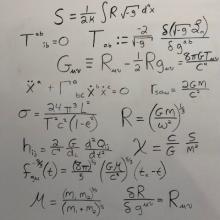
The General Theory of Relativity (GR) was a tremendous success by Albert Einstein in 1915, through pursing analytical reasoning and considerations of physical symmetries, in establishing a marvelously elegant formalism unifying space, time, gravity, light, matter and the laws governing their mutual interactions. Einstein also succeeded in analytically deriving from the general theory a series of specific physical model cases accessible to direct astronomical observational tests - and GR has thus far passed all of them, up to and including the 2015 direct observation of gravitational waves.
To this day, scientists work on analytically developing GR models for various physical systems, among them astrophysical compact objects such as white dwarves, neutron stars and black holes. These objects can be isolated or interacting with each other, as well as evolving and/or interacting with their environment, containing gas, magnetic fields, etc. Their evolution can emit strong electromagnetic or gravitational radiation, as well as neutrinos, and such systems are the prime candidates of interest in the age of multi-messenger astrophysics.
CCRG members explore such objects and systems, governed by GR, and develop analytical models used to solve diverse problems in describing and predicting their behaviours. These include, among others, studying stable black holes and their weak interactions using black hole perturbation theory, studying the stabilization of black holes through ringdown in quasi-normal modes, and studying systems of black holes and neutron stars in mutual orbits using the post-Newtonian and post-Minkowskian approximations to Einstein's GR field equations.
These methods are all also used to analytically predict the generation and form of gravitational waves emitted by such systems. These gravitational waveforms, as well as those prescribed using combinations of analytical, phenomenological, numerical and hybrid methods, are used both to search for gravitational waves, to analyze their properties once they are found, and to evaluate their consistency with GR versus other analytical theories of gravity.
At the CCRG, analytical methods are also used to produce simplified models to serve as a basis for solving problems computationally when required. These semi-analytic endeavors allow for the inclusion of additional physical effects, like magnetohydronamics, the standard model of nuclear interactions, and thus solve systems of compact objects immersed in gas and discs, as in typical astrophysical systems.
We also study the effects of gravitational waves thanks to mathematical models describing merging compact objects. Without the results of such models, merger signals in the data would be indistinguishable from the normal detector noise. Furthermore, we are interested in studying the effects of different mass/spin configurations, the introduction of matter, precession, and much more, but our detections are limited, and therefore require mathematical models of these different systems in order to study the results.






